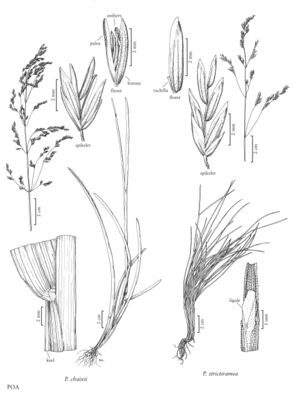Difference between revisions of "Poa strictiramea"
FNA>Volume Importer |
FNA>Volume Importer |
||
| Line 20: | Line 20: | ||
-->{{Treatment/Body | -->{{Treatment/Body | ||
|distribution=Tex. | |distribution=Tex. | ||
| − | |discussion=<p | + | |discussion=<p>Poa strictiramea grows on shady, upland mountain slopes, usually below north-facing cliffs, in and around the Chihuahuan Desert. In the United States, it is known only from the Chisos Mountains, Texas. It used to be treated as P. involuta Hitchc. Plants from the eastern part of its range, including the Chisos Mountains, commonly have short, truncate ligules, whereas westward in Mexico, plants with long, acute ligules are more common.</p> |
|tables= | |tables= | ||
|references= | |references= | ||
| Line 36: | Line 36: | ||
|basionyms= | |basionyms= | ||
|family=Poaceae | |family=Poaceae | ||
| + | |illustrator=Sandy Long | ||
|distribution=Tex. | |distribution=Tex. | ||
|reference=None | |reference=None | ||
| Line 41: | Line 42: | ||
|publication year= | |publication year= | ||
|special status= | |special status= | ||
| − | |source xml=https:// | + | |source xml=https://bibilujan@bitbucket.org/aafc-mbb/fna-data-curation.git/src/314eb390f968962f596ae85f506b4b3db8683b1b/coarse_grained_fna_xml/V24/V24_758.xml |
|subfamily=Poaceae subfam. Pooideae | |subfamily=Poaceae subfam. Pooideae | ||
|tribe=Poaceae tribe Poeae | |tribe=Poaceae tribe Poeae | ||
Revision as of 17:09, 30 October 2019
Plants perennial; densely tufted, not stoloniferous, not rhizomatous. Basal branching intra-vaginal. Culms 30-90 cm, slender to coarse. Sheaths closed for 1/20 – 1/10 their length, terete, scabrous, glabrous; collars smooth to scabrous; ligules 0.5-4(6) mm, scabrous, apices truncate to acute, entire or lacerate; innovation blades 15-30 cm; cauline blades 1-4 mm wide, involute or rarely flat, moderately thick and firm, both surfaces sparsely to densely antrorsely scabrous, apices narrowly prow-shaped, flag leaf blades usually longer than their sheaths. Panicles (7)10-30 cm, erect, pyramidal, open, with 2-5 branches per node; branches 2-8(15) cm, spreading, straight, angled, angles moderately to densely scabrous, sometimes densely scabrous all over, with 10-30 spikelets. Spikelets 4-7 mm, lanceolate, laterally compressed; florets 2-5; rachilla internodes 0.8-1.5 mm, smooth or scabrous, sometimes sparsely hispidulous. Glumes sparsely to rarely densely scabrous; lower glumes 1-3-veined; calluses usually glabrous, rarely sparsely short-webbed; lemmas 2.5-3.5 mm, lanceolate, distinctly keeled, smooth or sparsely to densely scabrous, keels and marginal veins glabrous or softly puberulent or short- to long-villous, lateral veins moderately prominent to prominent, intercostal regions usually glabrous, infrequently sparsely softly puberulent, apices acute; palea keels scabrous; anthers aborted late in development, or 2.2-2.5 mm. 2n = 28+1, 28-29+11.
Discussion
Poa strictiramea grows on shady, upland mountain slopes, usually below north-facing cliffs, in and around the Chihuahuan Desert. In the United States, it is known only from the Chisos Mountains, Texas. It used to be treated as P. involuta Hitchc. Plants from the eastern part of its range, including the Chisos Mountains, commonly have short, truncate ligules, whereas westward in Mexico, plants with long, acute ligules are more common.
Selected References
None.
